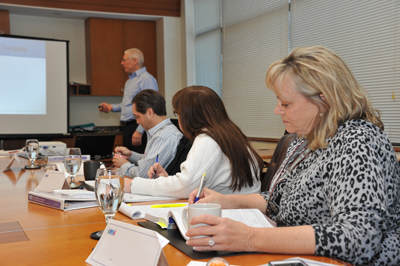Financial Statement Analysis 2: Credit & Risk Assessment
Event
- When:
- Mon, November 4, 2024 - Thu, November 7, 2024
- Where:
- NACM National Headquarters - Columbia, Maryland
- Category:
- Certification Courses
Description
A course for credit & risk analysts, CCE exam candidates and those striving to earn the new NACM Certified Credit & Risk Analyst (CCRA) certification
About the Program
This intermediate financial analysis program has been designed for credit analysts, risk analysts and managers seeking comprehensive understanding of what's behind the numbers in financial reports. It is designed to improve the credit & finance professional's ability to analyze and interpret financial statements leading to quality credit risk assessment. The program gives equal weight to the process of financial reporting, the analysis and interpretation of financial statements and the steps required to document a quality credit line recommendation.
Program Overview
This course is an excellent preparatory class for the Certified Credit Executive (CCE) designation exam. Using the textbook, Financial Reporting and Analysis - Custom Edition, by Charles H. Gibson, participants will receive in-depth exposure to:
- Investments: Short-and Long-term
- Receivables
- Inventories and Valuation Methods
- Fixed Assets and Depreciation
- Financing: Debt and Equity
- Financial Reporting for Leases
- Income Tax Reporting
- Ratio Analysis
- Cash Flow Analysis
- Credit Risk Assessment
Program Prerequisites
It is strongly recommended that participants have successfully completed a basic financial accounting course. In order to participate actively and gain the most from this course, students will need to join this class with a firm understanding of accounting concepts. Also, it is recommended that Financial Statement Analysis 1 be completed prior to this course.
Program Instructor
 George A. Schnupp, CCE, the 2008 National Credit Executive of the Year, is the Global Director of Credit at Anixter Inc. With over 29 years of experience in the credit profession, he has implemented various PC-based credit processes, eliminating numerous routine repetitive tasks performed by
George A. Schnupp, CCE, the 2008 National Credit Executive of the Year, is the Global Director of Credit at Anixter Inc. With over 29 years of experience in the credit profession, he has implemented various PC-based credit processes, eliminating numerous routine repetitive tasks performed by
credit personnel.
Mr. Schnupp is an instructor for NACM Midwest (Chicago Institute of Credit), William Rainey Harper College and NACM-National. He has taught Principles of Business Credit, Financial Accounting, Financial Statement Analysis I, Financial Statements: Interpretation and Credit Risk Assessment and Essentials of Finance. He is an alumnus of the NACM Graduate School of Credit & Financial Management and author of the course material for the CCE Prep Course. He was also a core contributor to the Principles of Business Credit textbook used in the Credit Administration Program (CAP).
Mr. Schnupp has served on numerous national committees, including the Accreditation and Education Committees. He continues to serve on the national CAP Instructors Committee and is the Chair of the Advanced Credit Administration Program Instructors Committee. In addition to being honored as the 2008 National Credit Executive of the Year, he was named the NACM/Robert Half Finance & Accounting and Accountemps Instructor of the Year in 2000 and the NACM Midwest Credit Executive of the Year.
General Information
 The Certificate Sessions are conducted at the NACM headquarters located in Columbia, Maryland.
The Certificate Sessions are conducted at the NACM headquarters located in Columbia, Maryland.
Find out how you can complete an NACM Certification Program requirement in one week.
Program Schedule
Day One – Monday
8:00 – 8:30am
Continental Breakfast
8:30am – 10:30am
Chapter 1: Introduction to Financial Reporting
You will learn the basic principles of accounting on which financial reports are based. A review of the evolution of GAAP and the traditional assumptions of the accounting model helps the participant understand the statements and thus analyze them better.
10:30 – 10:45am
Morning Break
10:45am to 12 noon
Chapter 2: Introduction to Financial Statements and Other Financial Reporting Topics
You will learn the forms of business entities and be introduced to financial statements. This chapter includes other financial reporting topics that contribute to the understanding of financial reporting, such as the auditor's report, management's responsibility for financial statements and the SEC's integrated disclosure system.
Noon – 1:00pm
Lunch
1:00 – 3:00pm
Chapter 3: Income Statement
You will learn all about the operating statement: revenues, expenses, gross margins, operating margins, net profit margins and special income statement items.
3:00 – 3:15pm
Afternoon Break
3:15 – 5:00pm
Chapter 4: Balance Sheet
You will learn all about the balance sheet and be introduced to consolidated statements and problems in balance sheet presentation. Special emphasis will be given to the investment choices in various assets being employed on the balance sheet.
5:30pm
Dinner at a Local Restaurant
All dinners are held at restaurants. A variety of dinner choices is always available.
Day Two – Tuesday
8:00 – 8:30am
Continental Breakfast
8:30 – 10:30am
Chapter 5: Liquidity of Short-Term Assets; Related Debt-Paying Ability
You will learn about the procedures necessary for analyzing short-term assets and the short-term debt-paying ability of an entity. There will be a detailed discussion of four very important current investments: cash, marketable securities, accounts receivable and inventory.
10:30 – 10:45am
Morning Break
10:45am – Noon
Chapter 6: Long-Term Debt-Paying Ability
You will two approaches to viewing a firm's long-term debt-paying ability. One approach views the firm's ability to carry the debt as indicated by the income statement, and the other considers the firm's ability to carry debt as indicated by the balance sheet
Noon to 1:00pm
Lunch
1:00 to 3:00pm
Chapter 4: Frazier Book – Statement of Cash Flow
You will learn the major sources and uses of cash reported in the operating, investing and financing sections of the statement of cash flows. You will also learn why accrual net income and operating cash flows differ and the factors that explain this difference. The difference between the direct and indirect method of determining cash flows from operations will be discussed. You will learn how to prepare a statement of cash flows from comparative balance sheet data, an income statement and other financial information. Special emphasis will be given to the operating activities related to working capital.
3:00 – 3:15pm
Afternoon Break
3:15 – 5:00pm.
Chapter 7: Statement of Cash Flows
Analyze and interpret all three activities in the Cash Flow Statement.
5:30pm
Dinner at a Local Restaurant
Day Three – Wednesday
8:00 – 8:30am
Continental Breakfast
8:30 – 10:30am
Chapter 8
You will learn how competitive forces and a company's business strategy influence its operating profitability. You will also learn how Return on Assets (ROA) can be used to analyze a company's operating profitability and what insights are gained from separating ROA into its profit margin and asset turnover components. Return on Equity (ROE) will also be studied to determine the impact of financial leverage on a company's operating profitability.
Appendix A
Margins, Turnover, Leverage & Liquidity
Appendix B
The Decision to Sell
10:30 – 10:45am
Morning Break
10:45am – Noon
Appendix C
Analysis What Now?
Appendix D
Return on Equity: Documenting Credit Risk
Appendix E
Methodology of Financial Statement Analysis
Noon – 1:00pm
Lunch
1:00 – 3:00pm
Appendix F
Accounting Profits versus Cash Profits
Appendix G
Roll for Margins, Turnover & Leverage
Case #1
Comprehensive Review
3:00 – 3:15pm
Afternoon Break
3:15 – 5:00pm
Case (continued)
5:00pm
Study Session and Pizza Party
Case #2
Comprehensive Review
Day Four – Thursday
8:00 – 8:30am
Continental Breakfast
8:30 – 10:00am
Review both Case Studies
10:00 – 10:15am
Morning Break
10:15am – Noon
Case Studies
Stock Performance
Noon – 1:00pm
Lunch
1:00 – 5:00pm
Evaluations & Final Exam
In order to give you sufficient time to take the final exam, we strongly recommend that your return flight be scheduled to depart after 5:00pm on the final day of the program or the following morning. Please do not plan on leaving the national office for the airport before 5:00pm.
Venue
- Location:
- NACM National Headquarters - Website




